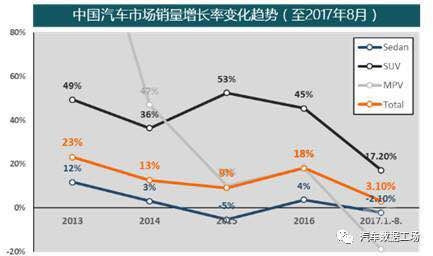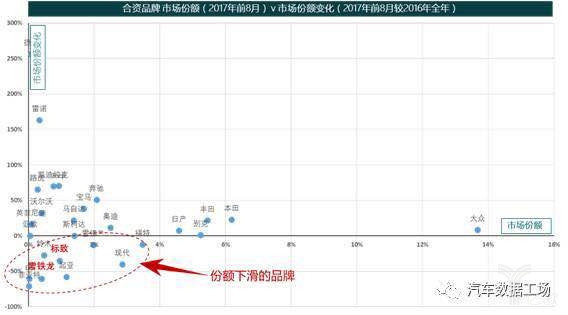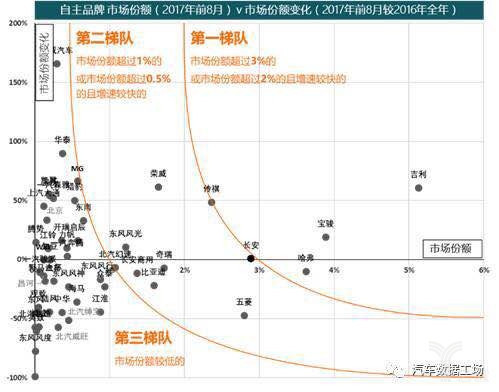Zero-sum game under traditional structure will continue Although the main theme of this year is change, we still need to start from the traditional car market because only this part is the easiest to touch and describe. First of all, we can see that the total growth of the automobile market in 2017 has really stopped. The reason why the word “really†was used here is because there have been many predictions about the stagnation of growth before, but in the end, either because of policy support or because the market’s own popularity process is not over yet, there are often more than double digits in the end. The growth rate. However, this year's growth rate is very close to the stagnation. The growth rate in the first eight months of this year was only 3.1%. In the following months, the market maintained this rhythm. Next, we can further see that once the market enters the zero-sum game stage, the good days of most brands really end. The brands that fell the most in 2017 were Beijing Hyundai, Dongfeng Yueda Kia, Peugeot, Citroen, Fiat and Chevrolet. In SoCar's system, these brands all belong to the so-called “parity brandâ€, which is the brand premium ability. Those just in the middle of the market, they used to be significantly higher than their own brands, but it is difficult to compete directly with the joint venture brands such as the Volkswagen Group and Toyota. But today they are gradually being chased by high-end self-owned brands and they have quickly lost their market position. (Changes in the sales growth rate of China's auto market) (Joint Brand Market Share V Market Share Change) Previously, we published a public report specifically on the problem of falling share of affordable brands. At that time, we concluded that the fall in parity brands was collective, related to the full rise of functional pricing brands (high-end autonomy), and also to Chinese auto consumers. Learn about the product's learning curve (the process of gradually understanding the car). In the short term, if parity brands cannot adjust their product and brand strategy, they will find it difficult to regain their original status. Therefore, for these brands in 2018, it may still be the year in which the share is lost. (Individual brand market share V market share changes) For an independent brand, the era of zero-sum game also means that the echelon of the market gradually becomes a steady-state structure. In 2017, there were some changes in the first echelon of the market: Chang’an almost fell out, Chuanxi was officially nominated, and SAIC had already officially entered the list if it added Roewe and MG together. Geely is a ride away, leaving other independent brands behind. In 2018, the overall trend of these self-owned brands will not change, but these brands entering the first echelon will need to really achieve the transformation of the growth model: In the past, they rely on superimposed models to rapidly increase sales. In the future, they will need to fully integrate their product mix and brand strategy. Combined, rely on real brand strategy to achieve long-term stability of market position. In this regard, there is a fundamental difference between the tactical level of victory and the long-term stability of the strategic level. This is the hurdle that the leading independent brand needs to take the next step. It is also worth mentioning that is the current fleet of third-tiered companies able to stop rebounding and rebounding due to Xu Liuping's airdrop? Can Chery find a long-term stable strategic direction? Is there a long time ago, BYD has officially entered the decline cycle? As for Haval, the old Chinese medicine admits that the brand's decline was judged prematurely last year, but in the long run, the structural imbalance of the brand is still there. Of course, the good start of WEY has largely relieved Haval's short-term risks. As for what follows, we must further observe. In the structural adjustment, the high-end trend of independent brands is the most noteworthy. Not only WEY and Collar (which, of course, counts the company as a joint venture brand more in line with the official statement), Roewe's I6 and the new MG6 have also successfully reached the long-term stable control of the APlusSedan market, such as Civic and other joint venture brands, and With an average monthly sales of 7,000 to 8,000 units, this record was unthinkable in the past. The Chuanqi GS8 also continued to maintain an average monthly sales volume of about 10,000 units, which are self-satisfied high-end achievements. Car quadruples may not be as large as the "destructive power" Having said that the traditional market itself relied on inertia and the possible changes in an orderly product iteration, we still focused on the topic of change that is generally concerned about in the industry today, which is what we often call the "four modernizations" (electricity, intelligence). , sharing, and joining together.) In November of this year, I was very fortunate to have been invited to give a speech at the forum of the 100 people. The theme at that time was how car companies formulated a brand strategy that crossed the cycle of change. It can be said that today all of us can see the end of this round of industry changes. Sadly, we do not know how long it will take to reach this end. What is even more sad is that few of us can see what will happen within five years. However, for the strategic planning departments of automotive companies, the trend of 5 to 10 years is the most important because they need to roll a generation of products while planning to develop the next generation of products. The two-cycle life cycle happens to be this time span. In other words, they have to make bolder risk decisions under more and more uncertainties. These decisions are too radical and will be delayed by lagging technology development or excessive costs. If they are too conservative, they will be eliminated by the market. Today we have to predict what will happen in 2018 or even the next five years. On this topic, after more than a year of discussions on industrial changes, I have calmed down a lot from my perspective. For example, with respect to the United Network, although a large number of Internet builders are trying to introduce their own disruptive in-vehicle interconnection system, we must pay attention to the cruel fact that everyone focuses on the driver’s networking. At the same time as demand, we did not even handle the networking needs of the first officer and the rear passengers! In other words, when the passengers in the car need to access the Internet, they first think of or pick up their own mobile phones, and by no means some kind of equipment on the car. This means that in today's all-sale vehicles, we have not found a decent demand that must be perfectly superimposed on the scene of traffic. Since those who do not need to drive during the trip do not have access to the Internet, or use the equipment on the bus to access the Internet, what do we use to attract drivers to go online? In today's driving mode, most of the demands we can think of are low-frequency, short-term, or kinky. This is a realistic issue that we need to seriously face. The above example reminds me of how big the disruptive disruption of the traditional automotive industry in the four modernizations of automobiles will be. In the end, my feelings are very different from those in early 2017: The advantages of traditional OEMs are obviously more pronounced. After all, they have enough experience in making cars, have enough effective sales and service networks, and they have a huge stock of users. Therefore, their safety boundary is far higher than the new forces of the constructors. From this point of view, at least the next 5 years, the traditional OEM is still safe, but the structural adjustment within the OEM will continue, as the first chapter of this article predicts, eventually there will be many brands are washed, there are some The brand went to the altar. In this trend, it is still difficult for me to see which new vehicle builders (except Tesla) have sufficient reasons to compete with traditional OEMs. Maybe they still want to accumulate enough experience and ability, but it is difficult to judge whether the speed of burning will match. In the next two years, that is, from 2018 to 2019, it is precisely the time when many concepts related to automobile quadrupleization will be examined by the market for the first time. There may be a lot of pseudo-innovations, but there are many concepts that need to be constantly improved and improved. At that time, it may well be a stage where the bubble bursts partially or even collapses in a large area. But it does not matter, the general direction of car quadruple will not change, in the short term everyone needs to experience a wave of shocks together. Of course, although I think that Sihuan has not been so damaging to the established pattern of the auto industry, there are still some phenomena that are worth noting. I will elaborate on the following two chapters. "Share trip" formally affects product definition These two days coincided with the days of the second quarter of the World Internet Conference held in China. Cheng Weigang just said that DDT will put 1 million EVs on the market before 2020. Previously, I also understood that Didi was in close contact with several car companies. The first step was to purchase existing vehicles, and the second step was to directly participate in the definition of products and customize products that are more in line with the drip usage scenarios. For the automotive market, this is a truly destructive force. 1 million what concept? Equivalent to sales of the third tier own brand 4 to 5 years. This means that if an order is handed over to any company, this brand alone can maintain the brand for two to three years (after all, 2B's cycle profit is definitely not as good as 2C, so the maintenance time should be discounted). However, if the sharing trend is established, the total demand of the automotive market is likely to decline on the premise that the total traffic demand of users remains unchanged. This will cause OEMs to face the prisoner's dilemma. (Of course, the opposite is true. I think sharing cars, especially time-sharing, will bring more people who originally used subways and buses to the self-driving market to stimulate car consumption. ). In any case, there are such orders placed here, OEMs must be rushing. This will cause companies like Didi to become a truly influential pole in the automotive market. Of course, I don't think that Didi could take over the shared car market in China. After all, the total amount of this market is too large, and the differences are very significant everywhere. Soon Cao Cao, Shenzhou, Shouqi and other companies will slowly find the feeling that only the market will establish a new balance. At the same time, the rapid development of the Internet-based car model is likely to really bring about the rise of the MPV that everyone (in fact, basically the industry) dreams of. Because the MPV seems to be more suitable for the use of the car than the car, the complaints about the appearance and driving pleasure of the most people have not been concerned about the car occupants. However, it is profitable to develop MPVs for network vehicles, which is a problem that OEMs need to judge themselves. Short-term pressure on the EV market, long-term waiting for a real breakthrough in battery technology Another topic for car quadrupleization is motorization. Last month, an article reported that China’s various capitals have already invested 450 billion yuan in new energy industries and started more than 70 new energy projects. Now that the policy has been fostered, but it is more about the suppression of traditional cars (mainly limited number of cities), China’s EV market has indeed made tremendous progress in the total amount, and the current amount of ownership is close to 100. 10,000 cars. But we must notice some other phenomena: 1. The government issued 15 new energy vehicle production qualifications, and also acquiesced to a large number of new Internet car manufacturers to join in 2. Policies further drive almost all traditional OEMs to the new energy market 3, subsidy in the rhythm of the slope 4. Today, nearly 70% of EVs are sold in 5 cities that are limited to licensing, and the remaining 30% are either Tesla or known beans. 5. The marginal effect of over-reliance on the limited-city sales contribution has already been greatly reduced, but in the next 2-3 years, the number of brand-new models put into the market will almost double every year, and the production capacity will also increase rapidly. 6. The distance between the battery technology and EVs is still overwhelmingly displacing the average household car by 200% (energy density greater than 800Wh/kg, cost less than 0.3 yuan/Wh, today's figure is 300Wh/kg and 1 yuan/Wh), and three Lithium-ion battery energy density limit is unable to support the previous target value 7, although the future of battery technology has many clues, such as solid-state batteries, but still not sure enough 8, all battery technology is currently difficult to leave the lithium ore resources, but the proven lithium ore in the world is not optimistic about supporting EV, even exhausted earlier than oil ...... All of the above phenomena tell us that perhaps the short-term bubble of EV has been formed, and it is very likely that there will be a tragic reshuffle between 2018 and 2019. Perhaps the market will return to rationality thereafter. Under the premise of existing technologies, everyone will adjust product development concepts to find market opportunities that can partially replace traditional automobiles, or discover new market opportunities. In short, the EV market will not be easy, and the danger may be in front China Switch Cabinet,Battery Charging Cabinet manufacturer, choose the high quality Solar Battery Storage Box,Solar Battery Cabinet, etc. Switch Cabinet Switch Cabinet,Battery Charging Cabinet,Solar Battery Storage Box,Solar Battery Cabinet Shenzhen Hongjiali New Energy Co., Ltd. , https://www.hjlcharger.com

